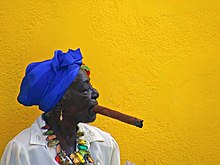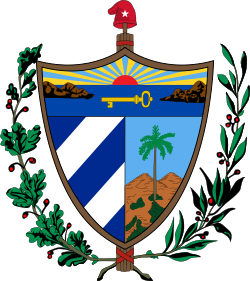Cubans
 Map of the Cuban Diaspora in the world | |
| Total population | |
|---|---|
| Cubans: ~13.9 million (2024) Diaspora: ~4.2 million | |
| Regions with significant populations | |
| 2,568,036 (2023)[4] [5] | |
| 223,532 (2023)[6][7] | |
| 50,355 (2024)[8] | |
| 25,976 (2020) ** | |
| 24,485 (2020)[5] | |
| 23,531 (2023) ** | |
| 19,545 (2021)[9][10] | |
| 19,068 (2022) | |
| 10,769 (2020)[11] | |
| 10,768 (2022)[12][11] | |
| 9,185 (2022)[13] | |
| 8,891 (2023)[14] | |
| 6,908 (2020)[11] | |
| 5,466 (2020)[11] | |
| 3,574 (2020)[11] | |
| 3,402 (2020)[11] | |
| 3,170 (2020)[11] | |
| 2,992 (2020)[11] | |
| 2,534 (2020)[11] | |
| 2,412 (2020)[11] | |
| 2,333 (2020)[11] [15][16][17] | |
| 2,224 (2020)[11] | |
| 2,194 (2020)[11] | |
| 1,021 (2023)[11] | |
| 1,971 (2020)[11] | |
| 1,926 (2020)[11] | |
| 1,858 (2020)[11] | |
| 1,846 (2020)[11] | |
| 1,825 (2020)[11] | |
| 1,714 (2020)[11] | |
| 1,501 (2020)[11] | |
| 1,185 (2020)[11] | |
| 1,116 (2020)[11]
Cubonics | |
| Religion | |
| Majority: Roman Catholicism[20] Minority: Irreligion, Protestantism, Santería, Ifá, Palo, Judaism, Islam[21] | |
| Related ethnic groups | |
| · Puerto Ricans · Floridanos · Spaniards · Africans · Taíno · Canarians · Catalans · Galicians · Andalusians · Portuguese · French | |
Cubans (Spanish: Cubanos) are the citizens and nationals of Cuba. The Cuban people have varied origins with the most spoken language being Spanish. The larger Cuban diaspora includes individuals that trace ancestry to Cuba and self-identify as Cuban but are not necessarily Cuban by citizenship. The United States has the largest Cuban population in the world after Cuba.
The modern nation of Cuba, located in the
Racial and ethnic groups
Census
The population of Cuba was 11,167,325 inhabitants in 2012.[22] The largest urban populations of Cubans in Cuba (2012) are to be found in Havana (2,106,146), Santiago de Cuba (506,037), Holguín (346,195), Camagüey (323,309), Santa Clara (240,543) and Guantánamo (228,436).[23] According to Cuba's Oficina Nacional de Estadisticas ONE 2012 Census, the population was 11,167,325 including: 5,570,825 men and 5,596,500 women.
| Year | White / % | Mulatto/ Mestizo / % |
Black / % | East Asian (Amarillo) / % | Total | ||||
|---|---|---|---|---|---|---|---|---|---|
| 1774 | 96,440 | 56.2 | 75,180 / 43.8 | ||||||
| 1861 | 793,484 | 56.8 | 603,046 / 43.2 | ||||||
| 1899 | 1,052,397 | 67.9 | 270,805 | TBD | 234,738 | TBD | 14,857 | TBD | |
| 1943 | 3,553,312 | 74.3 | 743,113 | 15.6 | 463,227 | 9.7 | 18,931 | 0.4 | |
| 2002 | 7,271,926 | 65.0 | 2,658,675 | 24.86 | 1,126,894 | 10,08 | 112,268 | 1,02 | |
| 2012 | 7,160,399 | 64.1 | 2,972,882 | 26.6 | 1,034,044 | 9.3 | - | - | |
European or white


In the 2012 Census of Cuba, 64.1% of the inhabitants self-identified as white. Based on genetic testing (2014) in Cuba, the average percentages of European, African and Native American ancestry in those auto-reporting to be white were 86%, 6.7%, and 7.8%, respectively.[27] The majority of the European ancestry comes from Spain.
Black or African
The Afro-Cuban population was 9.3% in the 2012 Census of Cuba. Just about 1.3 million Cubans described themselves as black.[22] Thus a significant proportion of those living on the island affirm some sub-Saharan African ancestry.
Based on genetic testing in 2014, the average African, European and Native American ancestry in those self-reporting to be "negro (Black)" was 65.5% "African", 29% "European" ancestry and 5.5% "Native American" or other ancestry.[27]
Although Afro-Cubans can be found throughout Cuba, Eastern Cuba has a higher concentration of Blacks than other parts of the island. Havana has the largest population of blacks of any city in Cuba.[28]
Multiracial

In the 2012 Census of Cuba, 26.6% (2.97 million) of the Cubans self-identified as mulatto or mestizo.[29]
East Asian
Officially called amarilla (yellow in English) in the Cuban census,
Amerindian
The number of people identifying as Taíno has not been formally recorded. Most of them live on the eastern part of the island, notably in Granma, Guantánamo, and Las Tunas.
The intermixing between European settlers and the native Taíno was prevalent in the early colonial era. Their mixed-race descendants have been historically undercounted.
According to a 2018 genome-wide data study, the eastern region of the island had an average Native American ancestry contribution of 10%, as compared to an average of 5% in the rest of the island.[32]
Additionally, many North American Indians living in
Intermarriage between diverse groups is so frequent as to be the rule.[33]
Arabs
Population changes
Cuba's birth rate (9.88 births per thousand population in 2006)[34] is one of the lowest in the Western Hemisphere. Its overall population increased from around 7 million in 1961 to 11 million today, but the rate of increase slowed over time and has recently turned to a decrease, with the Cuban government in 2006 reporting the first drop in the population since the Mariel boatlift. Immigration and emigration have had noticeable effects on the demographic profile of Cuba during the 20th century. Between 1900 and 1930, close to a million Spaniards migrated to the island.
Since 1959, over two million Cubans have left the island, primarily to
Genetics
An autosomal study from 2014 found the genetic ancestry in Cuba to be 72% European, 20% African and 8% Amerindian.[27] Of note, there is high variability between regions within Cuba, with individuals from Western provinces having higher European ancestry on average, and those in the Eastern region having more African and Native American genetic contribution.[32] Cuban genealogy has become a rising interest for Cubans in the last 15 years.[36]
A 1995 study done on the population of Pinar del Río, found that 50% of the Mt-DNA lineages (female lineages) could be traced back to Europeans, 46% to Africans and 3% to Americans. This figure is consistent with both the historical background of the region, and the current demographics of it. According to another study in 2008, regarding the geographical origin attributed to each mtDNA haplogroup, 55% of the sequences found in Cubans are of West Eurasian origin (namely, Europe and the Middle East) and 45% of African origin[37] Regarding
According to Fregel et al. (2009), the fact that autochthonous male E-M81 and female U6 lineages from the Canaries have been detected in Cuba and Iberoamerica, demonstrates that Canary Islanders with indigenous Guanche ancestors actively participated in the American colonization.[38]
Cubans abroad
The United States has the largest number of Cubans outside Cuba. As of 2023, the
The second largest Cuban diaspora is in Spain. As of 2019, there were 151,423 Cubans in Spain.[6] Smaller numbers of Cubans live in Brazil, Uruguay,[43] Italy*, Mexico*, and Canada.[44]
After the founding of the republic in 1902, a considerable migration (over 1 million) arrived from the
History


The first people known to have inhabited Cuba was the

Towards the end of the 19th century, Spain had lost most of its American possessions and a series of
During the first decades of the 20th century, USA interests were dominant and in Cuba, leading to large influence over the island. This ended in 1959 when
Culture and traditions

This section possibly contains original research. (October 2016) |
The culture of Cuba reflects the island's influences from various cultures, primarily
One of the most distinctive parts of Cuban culture is Cuban music and dancing, being well-known far outside the country. Well known Hispanic music styles such as mambo, salsa, rumba, cha-cha-chá, bolero, and son originated in Cuba. The origins of much of Cuban music can be found in the mix of Spanish and West African music, while American musical elements such as trombones and big band were also significant elements in the formation of Cuban music. Cuban literature includes some of the most well-known names of the islands, such as writer and independence hero José Martí in the late 19th century. More contemporary Cuban authors include Daína Chaviano, Pedro Juan Gutiérrez, Antonio Orlando Rodríguez, Zoé Valdés and Leonardo Padura Fuentes.[49]
The Spanish language is spoken by virtually all Cubans on the island itself. Cuban Spanish is characterized by the reduction of several consonants, a feature that it shares with other dialects of Caribbean Spanish as well as the Canary Islands. Many Cuban-Americans, while remaining fluent in Spanish, use American English as one of their daily languages.[50]
Religion
- Catholicism(60%)
- Protestantism and other Christians (5%)
- Others/African Religious (11%)
- Non-religious(24%)
Cuba's prevailing religion is Roman Catholicism, although in some instances it is profoundly modified and influenced through syncretism. A common syncretic religion is Santería, which combined the Yoruba religion of the African slaves with some Catholicism; it shows similarities to Brazilian Umbanda and has been receiving a degree of official support.[51]
The
Membership in
.
Cuba is home to a variety of syncretic religions of largely African cultural origin. According to a US State Department report,
Symbols

The flag of Cuba is red, white, and blue; and was first adopted by Narciso López on a suggestion by the poet Miguel Teurbe Tolón. The design incorporates three blue stripes, representing the three provinces of the time (Oriente, Centro, and Occidente), and two white stripes symbolizing the purity of the patriotic cause. The red triangle stands for the blood shed to free the nation. The white star in the triangle stands for independence.[55]
See also
- Cuban nationality law
- Afro-Hispanic
- Caribbean people
- Criollo people
- Cuban Americans
- Cuban exile
- Cuban Spanish
- Cubans in Italy
- Cuba-United States relations
- History of Cuban Nationality
- Hispanics
- List of Cubans
- List of Cuban Americans
- Spanish American
- White Hispanic
- Taíno
- Cuban migration to Miami
- Cuban immigration to the United States
- Cuban Mexicans
- Cuban cuisine
- Cuban Uruguayans
References
- ^ http://amp.miamiherald.com/news/nation-world/world/americas/cuba/article290249799.html. [bare URL]
- ^ http://www.onei.gob.cu/node/13815 Archived 14 March 2020 at the Wayback Machine. (in Spanish). Retrieved 2 July 2022
- ^ "Basic Facts". Census.gov. Archived from the original on 23 May 2022. Retrieved 10 December 2022.
- ^ "HISPANIC OR LATINO ORIGIN BY SPECIFIC ORIGIN". data.census.gov. 2022.
- ^ a b Pentón, Mario J. (13 February 2020). "Uruguay quiere atraer a cubanos y venezolanos, y lo está logrando". El Nuevo Herald (in Spanish). Archived from the original on 1 October 2021. Retrieved 1 December 2020.
- ^ a b c https://www.ine.es/jaxiT3/Tabla.htm?t=68522. Retrieved 10 January 2025.
- ^ "Instituto Nacional de Estadística. (National Statistics Institute)". ine.es. Archived from the original on 25 July 2020. Retrieved 8 August 2020.
- ^ Immigrants in Brazil (2024, in Portuguese)
- ^ https://www150.statcan.gc.ca/t1/tbl1/en/tv.action?pid=9810030201 Archived 2 February 2023 at the Wayback Machine. Retrieved 18 January 2023.
- ^ "Canada Census Profile 2021". Census Profile, 2021 Census. Statistics Canada Statistique Canada. 7 May 2021. Archived from the original on 3 January 2023. Retrieved 3 January 2023.
- ^ a b c d e f g h i j k l m n o p q r s t u v w https://countryeconomy.com/demography/migration/emigration/cuba Archived 22 August 2023 at the Wayback Machine. Data source: UN. Retrieved 22 August 2023.
- ^ https://www.primicias.ec/noticias/sociedad/censo-ecuador/inmigrantes-extranjeros-paises/. Retrieved 20 September 2024.
- ^ "Number of foreigners in Germany from 2019 to 2022, by country of origin". 31 December 2022.
- ^ "Place of Birth for the Foreign-Born Population in Puerto Rico". data.census.gov. 2022. Archived from the original on 27 September 2023. Retrieved 20 September 2023.
- ^ "Table QS213EW: 2011 Census: Country of birth (expanded), regions in England and Wales". Office for National Statistics. 26 March 2013. Archived from the original on 23 February 2016. Retrieved 10 July 2016.
- ^ "Country of birth (detailed)" (PDF). National Records of Scotland. Archived (PDF) from the original on 24 September 2015. Retrieved 10 July 2016.
- ^ "Country of Birth - Full Detail: QS206NI". Northern Ireland Statistics and Research Agency. Archived from the original (XLS) on 4 March 2016. Retrieved 10 July 2016.
- ^ https://serviciomigraciones.cl/estudios-migratorios/estimaciones-de-extranjeros/ Archived 9 July 2023 at the Wayback Machine Estimacion de Poblacion Extranjera en Chile, al 31 de diciembre de 2019. Source: INE de Chile. Retrieved 26 August 2022.
- ^ "Estimaciones de extranjeros" (in Spanish). Extranjeria.cl. Archived from the original on 9 July 2023. Retrieved 9 July 2023.
- ^ a b "RELIGION IN CUBA". Prolades.com. Archived from the original on 23 March 2017. Retrieved 9 August 2017.
- ^ "Central America :: Cuba — The World Factbook - Central Intelligence Agency". cia.gov. 18 October 2021. Archived from the original on 12 August 2021. Retrieved 24 January 2021.
- ^ a b c "Official 2012 Census" (PDF). One.cu. Archived from the original (PDF) on 3 June 2014. Retrieved 9 August 2017.
- ^ a b "2012 Official Census - Province, City and ethnic group" (PDF). One.cu. Archived from the original (PDF) on 25 March 2016. Retrieved 9 August 2017.
- ^ "Cifras censales comparadas, 1899 - 1953" (PDF). One.cu. p. 189. Archived from the original (PDF) on 29 October 2019. Retrieved 9 August 2017.
- ISBN 9780813549231. Archivedfrom the original on 27 September 2023. Retrieved 4 April 2020.
- ^ "El Color de la Piel según el Censo de Población y Viviendas" (PDF). Cuba Statistics and Information. pp. 17–18. Archived from the original (PDF) on 21 January 2022. Retrieved 8 February 2022.
- ^ PMID 25058410.
- ^ "Afro-Cubans". Minority Rights Group. 19 June 2015.
- ^ "Cuba - World Directory of Minorities & Indigenous Peoples". Minority Rights Group. 19 June 2015.
- ^ "El Color de la Piel según el Censo de Población y Viviendas" (PDF). Cuba Statistics and Information. pp. 8, 17–18. Archived from the original (PDF) on 21 January 2022. Retrieved 8 February 2022.
- ^ "Report on the Census of Cuba, Census of Cuba 1899". Digital.tcl.sc.edu. p. 81. Archived from the original on 8 October 2011. Retrieved 8 February 2022.
- ^ PMID 30061702.
- ISBN 9780521867870. Archivedfrom the original on 27 September 2023. Retrieved 10 November 2020.
- ^ "Population, birth rate falling in Cuba: Official". thepeninsulaqatar.com. Reuters. 17 May 2007. Archived from the original on 26 September 2007.
- ^ Quiñones, Rolando García. "International Migrations in Cuba: persisting trends and changes". Technical Corporation. Archived from the original on 20 August 2006. Retrieved 9 July 2006.
- ^ Padgett, Tim (17 July 2023). "Cubans look to genealogy as a way off the island". NPR. Retrieved 16 January 2024.
- ^ PMID 18644108.
- PMID 19650893.
- ^ https://data.census.gov/table/ACSDT1Y2022.B05006?q=B05006%20Place%20of%20Birth%20for%20the%20Foreign-Born%20Population%20in%20the%20United%20States. Retrieved 8 August 2024.
- ^ Gonzalez-Barrera, Ana; Krogstad, Jens Manuel (18 January 2018). "Naturalization rate among U.S. immigrants up since 2005, with India among the biggest gainers". Pew Research Center. Archived from the original on 10 April 2021. Retrieved 22 March 2021.
- ^ "Constitución de la República de Cuba, 1992" (PDF). ACNUR. Archived (PDF) from the original on 21 October 2018. Retrieved 21 October 2018.
Artículo 32.- Los cubanos no podrán ser privados de su ciudadanía, salvo por causas legalmente establecidas. Tampoco podrán ser privados del derecho a cambiar de esta. No se admitirá la doble ciudadanía. En consecuencia, cuando se adquiera una ciudadanía extranjera, se perderá la cubana. La ley establece el procedimiento a seguir para la formalización de la perdida de la ciudadanía y las autoridades facultadas para idirlo. / (English translation) Dual citizenship will not be admitted. Consequently, when foreign citizenship is acquired, Cuban citizenship will be lost.
- ^ "U.S. Census website". United States Census Bureau. United States Census Bureau. Archived from the original on 27 December 1996. Retrieved 19 September 2019.
- ^ "Hispanic Groups Population in USA by ORIGIN". www.census.gov/. 2023.
- ^ Government of Canada, Statistics Canada (8 February 2017). "Census Profile, 2016 Census - Canada [Country] and Canada [Country]". www12.statcan.gc.ca. Archived from the original on 18 February 2020. Retrieved 11 September 2020.
- ^ Espinosa Chepe, Oscar (1 December 2007). "Cuba and Spain – Relations and Contradictions". Archived from the original on 11 February 2009. Retrieved 9 June 2009.
- ^ "500,000 New Citizens for Spain?". Time. 29 December 2008. Archived from the original on 15 July 2010.
- ^ "Over 400 Cubans line up for Spanish citizenship". Cleveland.com. 30 December 2008. Archived from the original on 7 June 2011. Retrieved 9 August 2017.
- ^ "Cuba - Caribbean Music and Dance".
- ISBN 978-1-317-43437-5.
- ISBN 978-1-62616-510-6.
- ^ "Cuba - Spanish, Haitian Creole, Sign Language | Britannica". www.britannica.com.
- ^ a b "International Religious Freedom Report 2009: Cuba". US State Department. October 2009. Archived from the original on 30 November 2009. Retrieved 16 July 2010.
- ^ "Comunidades de Fe en Cuba: Primera parte de la serie de fondo de WOLA sobre la religión en Cuba". Wola.org (in Spanish). Archived from the original on 1 November 2014. Retrieved 9 August 2017.
- ^ "La Pampa - Cada uno en lo suyo, con coincidencias y discrepancias". Laarena.com.ar. Archived from the original on 8 December 2015. Retrieved 9 August 2017.
- ^ Carlos Márquez Sterling; Manuel Márquez Sterling (1975). Historia de la isla de Cuba. p. 77.
